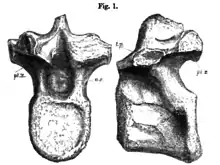Syngonosaurus
Syngonosaurus is an extinct genus of ornithopod dinosaur from the Early Cretaceous. It was an iguanodontian discovered in England[1] and was first described in 1879. The type species, S. macrocercus, was described by British paleontologist Harry Seeley in 1879[2] and it was later synonymised with Acanthopholis, but the genus was reinstated in a 2020 study, when Syngonosaurus and Eucercosaurus were reinterpreted as basal iguanodontians.[3]
| Syngonosaurus | |
|---|---|
 | |
| Vertebra seen from two different angles | |
| Scientific classification | |
| Kingdom: | |
| Phylum: | |
| Class: | |
| Superorder: | |
| Order: | |
| Suborder: | |
| (unranked): | |
| Genus: | †Syngonosaurus Seeley, 1879 |
| Binomial name | |
| †Syngonosaurus macrocercus Seeley, 1879 | |
History
.jpg.webp)
In 1869 Harry Govier Seeley named several new species of Acanthopholis based on remains from the Cambridge Greensand: Acanthopholis macrocercus, based on specimens CAMSM B55570-55609; Acanthopholis platypus (CAMSM B55454-55461);[4] and Acanthopholis stereocercus (CAMSM B55558 55569).[5] Later, Seeley split the material of Acanthopholis stereocercus and based a new species of Anoplosaurus on part of it: Anoplosaurus major. He also described a new species, Acanthopholis eucercus, on the basis of six caudal vertebrae (CAMSM 55552-55557).[2] In 1902 however Franz Nopcsa changed it into another species of Acanthopholis: Acanthopholis major. Nopcsa at the same time renamed Anoplosaurus curtonotus into Acanthopholis curtonotus. In 1879 Seeley named the genus Syngonosaurus based on part of the type material of A. macrocercus.[2] In 1956 Friedrich von Huene renamed A. platypus into Macrurosaurus platypus.[6]
In 1999 Xabier Pereda-Superbiola and Paul M. Barrett reviewed all Acanthopholis material. They concluded that all species were nomina dubia whose syntype specimens were composites of non-diagnostic ankylosaur and ornithopod remains; including Syngonosaurus.[7] Syngonosaurus was seen as an ankylosaur in both a 2001 publication[1] and a 2004 publication.[8] Syngonosaurus was synonymised with Acanthopholis in 1999, but the genus was reinstated in a 2020 study, when Syngonosaurus and Eucercosaurus were reinterpreted as basal iguanodontians.[3]
References
- Carpenter, Kenneth (2001). "Phylogenetic Analysis of Ankylosauria". In Carpenter, Kenneth (ed.). The Armored Dinosaurs. Indiana University Press. pp. 455–480. ISBN 0-253-33964-2.
- Seeley, H.G. (1879). "On the Dinosauria of the Cambridge Greensand". Quarterly Journal of the Geological Society. 35 (1–4): 591–636. doi:10.1144/GSL.JGS.1879.035.01-04.42. ISSN 0370-291X. S2CID 129277596.
- Barrett, Paul M.; Bonsor, Joseph A. (2020). "A revision of the non-avian dinosaurs Eucercosaurus tanyspondylus and Syngonosaurus macrocercus from the Cambridge Greensand, UK". Cretaceous Research. 118: 104638. doi:10.1016/j.cretres.2020.104638.
- Seeley, H.G. (1871). "XXXVII.— On Acanthopholis platypus (Seeley), a Pachypod from the Cambridge Upper Greensand". Annals and Magazine of Natural History. 8 (47): 305–318. doi:10.1080/00222937108696494. ISSN 0374-5481.
- Seeley, H.G. (1869). Index to the Fossil Remains of Aves, Ornithosauria, and Reptilia from the Secondary Strata arranged in the Woodwardian Museum of the University of Cambridge. Deighton, Bell and Company. pp. xvii.
- von Huene, F. (1956) "Palaeontologie und Phylogenie der niederen Tetrapoden"
- Superbiola, X.P.; Barrett, P.M. (1999). "A systematic review of ankylosaurian dinosaur remains from the Albian-Cenomanian of England". Special Papers in Palaeontology. 60: 177–208.
- M. K. Vickaryous, T. Maryanska, and D. B. Weishampel. 2004. Ankylosauria. In D. B. Weishampel, P. Dodson, and H. Osmolska (eds.), The Dinosauria (second edition). University of California Press, Berkeley 363-392